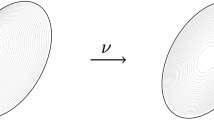Abstract
Flow in a circular pipe is investigated experimentally at Reynolds numbers higher than that at which the resistance coefficients calculated from the Blasius formula for laminar flow and from the Prandtl formula for turbulent flow are equal. The corresponding Reynolds number based on the mean-flow velocity and the pipe diameter is about 1000. The experiments were performed at a high level of inlet pulsations produced by feeding gas into the pipe through a hole with a diameter several times smaller than the pipe diameter. In our experiments the critical Reynolds number was determined as the value, independent of the distance from the inlet, at which the ratio of the axial to the mean-flow velocity as a function of the Reynolds number deviated from 2. At the maximum ratio of the pipe cross-sectional area to the area of the hole through which the gas entered the pipe, equal to ∼26, the critical Reynolds number was about 2300. After a fivefold increase in the hole area the critical Reynolds number increased by approximately 4%.
At Reynolds numbers below 2000, after at a high level of the inlet pulsations an almost laminar flow had developed in the pipe, a perturbation was introduced by inserting a diametrically oriented cylindrical rod with a diameter 10–20 times smaller than the pipe diameter. In these experiments, at Reynolds numbers higher than 1000, at a distance from the rod equal to 50 pipe diameters the axial to mean-flow velocity ratio was less than 2, approaching this value again at large distances from the rod. The insertion of the rod led to a decrease in the critical Reynolds number by approximately 12%.
Similar content being viewed by others
REFERENCES
O. Reynolds, "On the dynamical theory of incompressible viscous fluids and the determination of the criterion," Phil. Trans. Roy. Soc., A 186, 123–164 (1895).
O. Tietjens, Hydro-und Aeromechanik. Bd. 2. Bewegung reibender Fl¨ussigkeiten und technische Anwendungen, Springer, Berlin (1931).
L. Schiller, Hydro-und Aeromechanik, Akad. Verlag, Leipzig (1932).
L. Prandtl, F¨uhrer durch die Strömungslehre, Vieweg, Braunschweig (1949).
H. Schlichting, Grenzschicht Theorie, Braun, Karlsruhe (1951).
A. S. Monin and A. M. Yaglom, Statistical Hydrodynamics. Turbulence Mechanics [in Russian], Pt. 1, Nauka, Moscow (1965).
R. R. Chugaev, Hydraulics. Engineering Fluid Mechanics [in Russian], Energoizdat, Leningrad (1982).
L. D. Landau and E. M. Lifshits, Theoretical Physics. V. 6. Hydrodynamics [in Russian], Nauka, Moscow (1986).
D. J. Tritton, Physical Fluid Dynamics, Clarendon Press, Oxford (1988).
T. E. Faber, Fluid Dynamics for Physicists, Cambridge University Press, Cambridge (1995).
A. G. Darbyshire and T. Mullin, "Transition to turbulence in constant-mass-flux pipe flow," J. Fluid Mech., 289, 83–114 (1995).
A. A. Pavelyev and A. I. Reshmin, "Turbulent transition in the inlet region of a circular pipe," Izv Ros. Akad. Nauk, Mekh. Zhidk. Gaza, No. 4, 113–121 (2001).
Rights and permissions
About this article
Cite this article
Pavelyev, A.A., Reshmin, A.I., Teplovodskii, S.K. et al. On the Lower Critical Reynolds Number for Flow in a Circular Pipe. Fluid Dynamics 38, 545–551 (2003). https://doi.org/10.1023/A:1026369727130
Issue Date:
DOI: https://doi.org/10.1023/A:1026369727130




